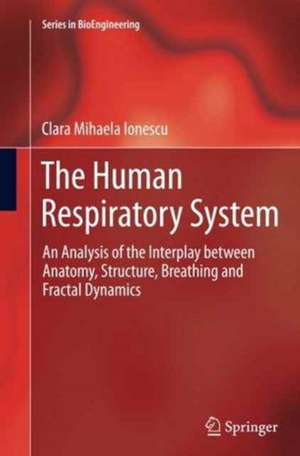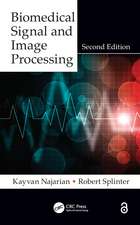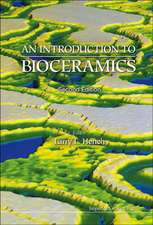The Human Respiratory System: An Analysis of the Interplay between Anatomy, Structure, Breathing and Fractal Dynamics: Series in BioEngineering
Autor Clara Mihaela Ionescuen Limba Engleză Paperback – 23 aug 2016
The text reveals the latest trends in modelling and identification of human respiratory parameters with a view to developing diagnosis and monitoring technologies. Of special interest is the notion of fractal structure which is indicative of the large-scale biological efficiency of the pulmonary system. The related idea of fractal dimension represents the adaptations in fractal structure caused by environmental factors, notably including disease. These basics are linked to model the dynamical patterns of breathing as a whole.
The ideas presented in the book are validated using real data generated from healthy subjects and respiratory patients and rest on non-invasive measurement methods.
The Human Respiratory System will be of interest to applied mathematicians studying the modelling of biological systems, to clinicians with interests outside the traditional borders of medicine, and to engineers working with technologies of either direct medical significance or for mitigating changes in the respiratory system caused by, for example, high-altitude or deep-sea environments.
| Toate formatele și edițiile | Preț | Express |
|---|---|---|
| Paperback (1) | 1038.66 lei 38-44 zile | |
| SPRINGER LONDON – 23 aug 2016 | 1038.66 lei 38-44 zile | |
| Hardback (1) | 1164.31 lei 6-8 săpt. | |
| SPRINGER LONDON – 19 sep 2013 | 1164.31 lei 6-8 săpt. |
Din seria Series in BioEngineering
- 15%
 Preț: 576.89 lei
Preț: 576.89 lei - 5%
 Preț: 995.67 lei
Preț: 995.67 lei - 5%
 Preț: 1164.31 lei
Preț: 1164.31 lei - 5%
 Preț: 720.84 lei
Preț: 720.84 lei - 5%
 Preț: 716.45 lei
Preț: 716.45 lei - 15%
 Preț: 643.65 lei
Preț: 643.65 lei - 5%
 Preț: 729.98 lei
Preț: 729.98 lei - 5%
 Preț: 711.88 lei
Preț: 711.88 lei - 5%
 Preț: 1104.48 lei
Preț: 1104.48 lei - 5%
 Preț: 1432.38 lei
Preț: 1432.38 lei - 5%
 Preț: 1413.56 lei
Preț: 1413.56 lei - 5%
 Preț: 1100.09 lei
Preț: 1100.09 lei - 5%
 Preț: 1289.76 lei
Preț: 1289.76 lei - 5%
 Preț: 727.08 lei
Preț: 727.08 lei - 5%
 Preț: 1299.81 lei
Preț: 1299.81 lei - 5%
 Preț: 719.02 lei
Preț: 719.02 lei - 5%
 Preț: 1166.49 lei
Preț: 1166.49 lei - 5%
 Preț: 724.29 lei
Preț: 724.29 lei - 15%
 Preț: 639.90 lei
Preț: 639.90 lei - 5%
 Preț: 1288.99 lei
Preț: 1288.99 lei - 18%
 Preț: 726.37 lei
Preț: 726.37 lei - 5%
 Preț: 1048.90 lei
Preț: 1048.90 lei - 5%
 Preț: 1164.10 lei
Preț: 1164.10 lei - 5%
 Preț: 1165.40 lei
Preț: 1165.40 lei - 5%
 Preț: 714.46 lei
Preț: 714.46 lei - 5%
 Preț: 1150.98 lei
Preț: 1150.98 lei - 5%
 Preț: 643.85 lei
Preț: 643.85 lei - 5%
 Preț: 1291.57 lei
Preț: 1291.57 lei - 15%
 Preț: 638.57 lei
Preț: 638.57 lei
Preț: 1038.66 lei
Preț vechi: 1093.32 lei
-5% Nou
Puncte Express: 1558
Preț estimativ în valută:
198.77€ • 205.07$ • 168.23£
198.77€ • 205.07$ • 168.23£
Carte tipărită la comandă
Livrare economică 28 februarie-06 martie
Preluare comenzi: 021 569.72.76
Specificații
ISBN-13: 9781447171836
ISBN-10: 1447171837
Pagini: 242
Ilustrații: XXV, 217 p. 148 illus., 129 illus. in color.
Dimensiuni: 155 x 235 mm
Ediția:Softcover reprint of the original 1st ed. 2013
Editura: SPRINGER LONDON
Colecția Springer
Seria Series in BioEngineering
Locul publicării:London, United Kingdom
ISBN-10: 1447171837
Pagini: 242
Ilustrații: XXV, 217 p. 148 illus., 129 illus. in color.
Dimensiuni: 155 x 235 mm
Ediția:Softcover reprint of the original 1st ed. 2013
Editura: SPRINGER LONDON
Colecția Springer
Seria Series in BioEngineering
Locul publicării:London, United Kingdom
Cuprins
Introduction.- The Human Respiratory System.- Respiratory Impedance.- Modelling the Respiratory Tract by Means of Electrical Analogy.- Mathematical Basis for Modelling.- Modelling the Respiratory Tract by Means of Mechanical Analogy.- Frequency Domain: Parametric Model Selection.- Time Domain: Fractal Dimension.- Nonlinear Effects in Measurement of Respiratory Impedance.- Conclusion.- Appendices: Mathematical Basis of Fractional Calculus; Overview of Forced Oscillation Technique Devices.
Notă biografică
Clara Ionescu received her MSc in industrial informatics and automation for “Dunarea de Jos” University in Galati, Romania in 2003. The subject of her study being modelling of the respiratory system by means of forced oscillations. She obtained her PhD from Ghent University in 2009 studying the identification of the human respiratory system using fractional-order models. Currently she is a post-doctoral fellow of the Flanders Scientific Research Centre. She has eight years’ expertise in modelling and control of biomedical systems (respiratory control, control of artificial muscles, glucose-level regulation for Type I diabetes, automated control of anaesthesia). She has around 150 peer-reviewed publications in journals, conferences and book chapters and is actively involved in the promotion of the concept of fractality in biological systems and its application in medicine.
Textul de pe ultima copertă
The Human Respiratory System combines emerging ideas from biology and mathematics to show the reader how to produce models for the development of biomedical engineering applications associated with the lungs and airways. Mathematically mature but in its infancy as far as engineering uses are concerned, fractional calculus is the basis of the methods chosen for system analysis and modelling. This reflects two decades’ worth of conceptual development which is now suitable for bringing to bear in biomedical engineering.
The text reveals the latest trends in modelling and identification of human respiratory parameters with a view to developing diagnosis and monitoring technologies. Of special interest is the notion of fractal structure which is indicative of the large-scale biological efficiency of the pulmonary system. The related idea of fractal dimension represents the adaptations in fractal structure caused by environmental factors, notably including disease. These basics are linked to model the dynamical patterns of breathing as a whole.
The ideas presented in the book are validated using real data generated from healthy subjects and respiratory patients and rest on non-invasive measurement methods.
The Human Respiratory System will be of interest to applied mathematicians studying the modelling of biological systems, to clinicians with interests outside the traditional borders of medicine, and to engineers working with technologies of either direct medical significance or for mitigating changes in the respiratory system caused by, for example, high-altitude or deep-sea environments.
The text reveals the latest trends in modelling and identification of human respiratory parameters with a view to developing diagnosis and monitoring technologies. Of special interest is the notion of fractal structure which is indicative of the large-scale biological efficiency of the pulmonary system. The related idea of fractal dimension represents the adaptations in fractal structure caused by environmental factors, notably including disease. These basics are linked to model the dynamical patterns of breathing as a whole.
The ideas presented in the book are validated using real data generated from healthy subjects and respiratory patients and rest on non-invasive measurement methods.
The Human Respiratory System will be of interest to applied mathematicians studying the modelling of biological systems, to clinicians with interests outside the traditional borders of medicine, and to engineers working with technologies of either direct medical significance or for mitigating changes in the respiratory system caused by, for example, high-altitude or deep-sea environments.
Caracteristici
Relates the ideas of fractal structure and fractal dimension to the dynamical pattern of breathing A significant step forward in modelling, identification and evaluation of the respiratory system in healthy and breathing-impaired subjects Packed with patient-based data offering real-world validation of the ideas described Includes supplementary material: sn.pub/extras












